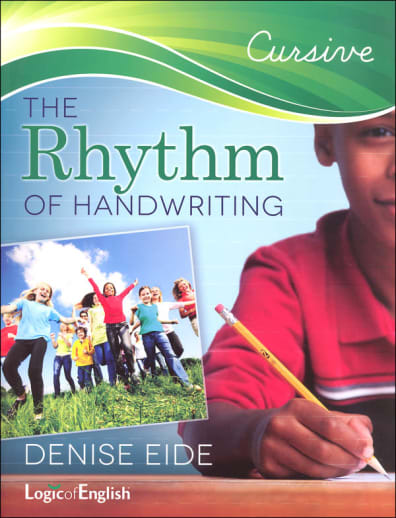2nd edition also includes instruction on writing numbers 0-9 and handwriting strokes.
Rhythm of Handwriting Cursive Book (2nd Edition)
Description
Logic of English wanted a custom font that was developmentally appropriate for young students and helpful for students struggling with handwriting. We worked with David Occhino Design to create the School LOE™ font, which they released in 2013 in both manuscript and cursive. The Rhythm of Handwriting Student Book guides you through all the steps needed to help your student develop rhythmic, fluid, comfortable handwriting.
Cursive Program Highlights
- All lowercase letters begin on the baseline.
- Uppercase letters only connect to the next letter if they end on the baseline.
- The capital Q has been simplified to reflect the manuscript version.
- Letter formation is closely matched to the manuscript font to facilitate ease in transition from one to another.
The Rhythm of Handwriting Cursive Student Book can stand alone as a handwriting curriculum, but we recommend supplementing the workbook with one or more of our Handwriting Supplements with the program.
If you are teaching Foundations, Rhythm of Handwriting instruction is completely incorporated into the curriculum, so you do not need to buy the handwriting book separately.
Originally part of the Logic of English program, The Rhythm of Handwriting is now available as a stand-alone course that teaches motion mastery and reinforces phonemic awareness. Beginning students practice letters using large-motor movements first. While the author of that program prefers that students learn cursive first, books are available in both manuscript and cursive. Both use a style that minimizes fine motor articulation and develops rhythmic handwriting. Lessons include a variety of line sizes making them usable for students at different levels of fine motor development. Letters are taught in groups based on initial stroke; a logical approach that also encourages muscle memory. Supplements to the handwriting program include tactile cards and quick reference charts. Each 2-page reference chart has a fold-out flap demonstrating the 14 types of strokes needed to make all the letters. The body of the chart shows how to form example letters grouped by type of stroke. Letters are formed on a short line segment with midline, accompanied by written instructions. And, for the teacher, the 11 steps for teaching handwriting are included as a reminder.
| Product Format: | Softcover Book |
|---|---|
| Grades: | K-AD |
| Brand: | Logic of English |
| ISBN: | 9781936706709 |
| Length in Inches: | 11 |
| Width in Inches: | 8.5 |
| Height in Inches: | 0.625 |
| Weight in Pounds: | 1.5125 |

